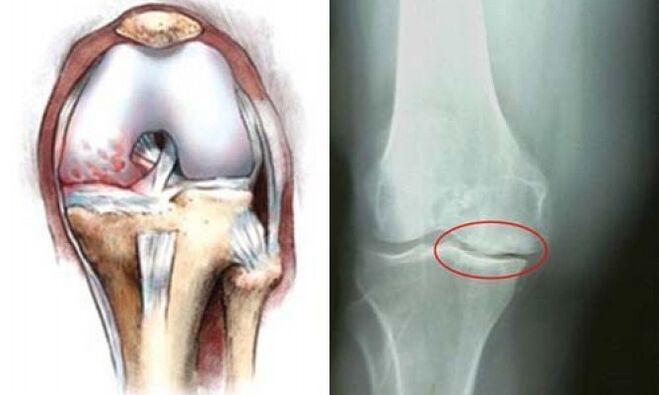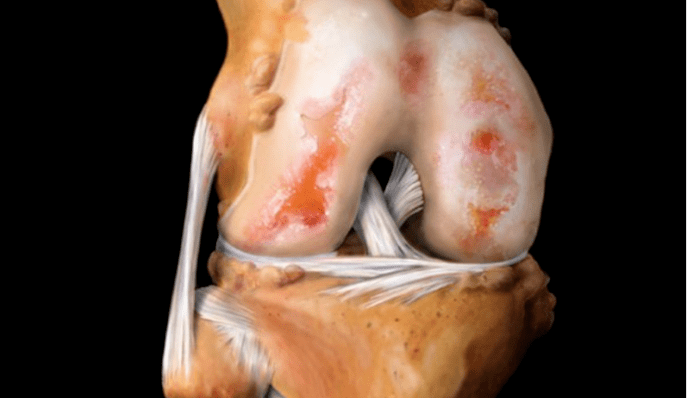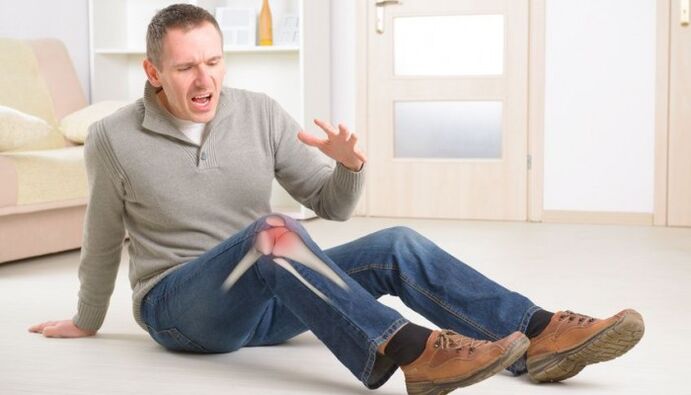Osteoarthritis of the knee joint is very common in older people, especially women. It is also diagnosed in young people. This disease significantly decreases the quality of life and, if not treated properly, can lead to disability.
How do you recognize osteoarthritis? What are the causes of this disease? how to cure it
sign
Osteoarthritis is a lesion of the hyaline cartilage of the joint. This cartilage is gradually destroyed. First its structure, density changes, then it becomes thinner. In severe cases, the cartilage may be completely absent.
The knee joint is always quite heavily loaded as it is one of the major structural elements of the lower extremity. Therefore, signs of arthrosis of the knee joint are noticeable even with minor joint damage.
With osteoarthritis of the knee, symptoms are associated with pain and a gradual loss of knee function.
There are three stages in the development of the disease. Each of them has characteristic symptoms and requires appropriate treatment.
First stage
The first phase can vary in length for different people. In some, the changes in the joints progress rapidly, and after a few months the disease progresses to the next stage. In others, dystrophy of the cartilage structure occurs slowly, years elapsing before new symptoms appear.
Signs of the first stage of knee osteoarthritis:
- Intermittent pain in one or both knees. It usually occurs in the morning when trying to take your first steps, during prolonged standing, or when climbing stairs or stairs. The reason for the appearance of a particularly pronounced soreness is the descent of stairs. There is no pain at rest.
- During intensive movements in the joint area, people often complain about a slight feeling of stiffness. However, changes in the movement amplitude are not observed.
- Fluid in the joint cavity can cause slight deformations, but the bone is not changed.
All of these symptoms indicate the need to see a doctor. If you start treatment at this stage, there is an opportunity not only to stop the process, but also to initiate restorative processes in some parts of the cartilage.
Second floor
If you do not consult a doctor, the disease will go to the next, second stage. At the same time, old symptoms are aggravated and additional ailments appear.
Signs that suggest osteoarthritis has progressed to stage two:
- The pain intensifies. It occurs with every foot movement. The symptoms are particularly pronounced when walking for long periods and lifting heavy objects. With rest, the pain gradually subsides.
- When moving, there is pain and a crunch from the affected joint.
- The range of motion begins to decrease, which can lead to discomfort. When a person tries to bend the leg at the knee to the limit, he either fails, or the bending causes severe pain.
- Upon examination, the doctor will note small changes in the shape of the joint. If an X-ray is taken, you can see that the joint space is too narrow and growths are forming on the bony edges.
- A large amount of fluid can accumulate in the joint cavity. This can be detected during diagnostic procedures and during routine examinations.
Most of the time, patients go to the doctor at this stage. In this situation, it is very difficult to achieve significant recovery, but some positive changes are possible.
Third section

The third stage occurs with severe destruction of the cartilage and is the most severe. Complaints and examination results of a patient with osteoarthritis of the third stage:
- Severe, almost constant pain in the affected joint. It increases when you try to move. At rest, even when lying on your back, the pain does not go away, leading to sleep disturbances.
- Movement in the joint is severely restricted.
- Often the knee "freezes" in a slightly bent state. This affects the shape of the leg and the gait of the patient.
- On examination, there is a clear deformity of the joint and bones.
- X-ray shows the absence of cartilage in many areas of the articular surface, bone sclerosis. The joint space is severely narrowed, there is a large number of osteophytes.
These patients are particularly difficult to treat. You may even need surgery.
The reasons
The causes of arthrosis of the knee joint are very diverse. Very rarely, a person diagnosed with this disease has only one factor that caused the pathological process. In most cases, cartilage changes have several causes. The more risk factors, the more intense the destruction and loss of function.
Most often, arthritis is provoked by such features of the body and circumstances:
- age-related changes in the structure of the musculoskeletal system;
- Knee injuries, as well as surgeries that can cause joint damage;
- too much load on the lower limbs;
- congenital anomalies of the musculoskeletal system or metabolic processes;
- inflammatory processes of various origins in the knee area.
Let's take a closer look at these groups of causes.
age changes

Most often, arthrosis of the knee develops after 40 years. This is because at this age and older, the structure of bone and cartilage tissue becomes more fragile and their resistance to stress decreases. Therefore, even long walks can be difficult for the joints of the lower extremities to endure.
The changes in the musculoskeletal system are particularly pronounced in women during menopause.
During this time, estrogen levels, which previously protected bones from calcium loss, gradually decrease, making them more vulnerable.
injuries and surgeries
In young people, osteoarthritis can occur due to trauma. It could be a broken leg, a dislocated knee, a torn ligament, or a serious contusion. The longer the time from the moment of injury to the right assistance, the higher the risk of complications and the occurrence of arthrosis in the near future. Therefore, even with minor knee injuries, you need to go to the hospital.
There is also a high risk of developing osteoarthritis after surgical interventions in the knee area. The removal of menisci is particularly dangerous. Osteoarthritis occurs in about 80% of patients after such an operation.
Traumatic osteoarthritis usually develops quickly. Therefore, in such cases, surgical intervention may be required.
overload
Excessive stress on the knees is observed in athletes professionally involved in sports such as running, jumping and weightlifting. The older a person gets, the more carefully they should choose physical exercise options in training. Squats, sudden movements and jogging on paved paths are particularly dangerous for the knees.
Excessive stress on the leg joints is typical for people who are overweight. Then the dead weight creates too much pressure on the cartilage and bones, which leads to their rapid wear.
Congenital pathologies

In the case of diseases of the musculoskeletal system and metabolic processes, this can also affect the knee joints.
Congenital pathological conditions that mean a high risk of developing osteoarthritis:
- anomalies of the knee joint;
- flat feet;
- salt metabolism disorders;
- ligament weakness.
If you are aware of such problems, it is important to pay special attention to knee pain, not ignore it and try to work closely with doctors.
Inflammatory phenomena
With arthritis of various etiologies, a large amount of fluid can accumulate in the joint. This leads to the fact that the blood circulation is disturbed, nutrients do not reach the bones and cartilage, the structure of the cartilage tissue is destroyed. As a result, secondary arthrosis develops.
No less dangerous are inflammatory processes in the vessels of the legs that feed the knee. If they are clogged with a thrombus, the blood supply is sharply reduced, which leads to degenerative processes in the cartilage.
treatment
Therapy is prescribed taking into account the degree of development of the disease, its causes and the general condition of the body. Osteoarthritis treatment principles:
- pain relief;
- improved supply of nutrients to the cartilage;
- stimulation of recovery processes;
- an increase in the space of the joint space to reduce pressure on the damaged cartilage;
- strengthening and restoring the functions of the muscles surrounding the joint;
- maximum restoration of motor skills.
There are several treatment options for osteoarthritis of the knee. Usually they include a complex of therapeutic procedures.
What can be prescribed to treat this disease:
- therapeutic exercises. They are selected by the orthopedist separately for each patient. If you try to form a complex yourself, engage in pain, the damage to the joint will progress.
- Diet.
- surgery, prosthetics.
- Drug treatment: nonsteroidal anti-inflammatory drugs (tablets or injections), painkillers, chondroprotectors, injection of glucocorticoids or hyaluronic acid preparations into the joint.
- Additional procedures: hirudotherapy, massage, magnetotherapy, warming up with paraffin or ozokerite, electrophoresis, manual therapy and others.
If you feel pain in the joint, you should consult a doctor. Timely treatment is the key to successful treatment.




















